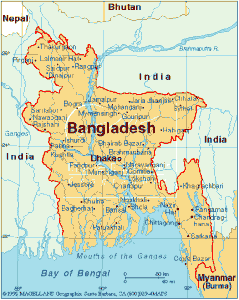- Bangladesh is situated in the deltaic plain formed by three large rivers – the Ganges, the Brahmaputra and the Meghna. The combined total catchment of about 1.7 million km2 extends over Bhutan, China, India and Nepal. Only about 7% of this huge catchment lies in Bangladesh.
- Most of Bangladesh is low-lying and relatively flat. A network of about 230 rivers, of which 57 are transboundary, forms a web of interconnecting channels throughout the country.
- Bangladesh has a subtropical monsoon climate, characterized by wide seasonal variations in rainfall, moderately warm temperatures and high humidity, with a hot, humid summer from March to June; a cool, rainy monsoon season from July to October; and a cool, dry winter from November to February. The annual rainfall varies from 1,200 mm in the north-west to more than 4,000 mm in the north-east.
- About 90% of the annual rainfall occurs during the monsoon season. From November to May there is almost no dependable rainfall. Drought is widespread during this dry period, and irrigation becomes necessary for any crop production.
- A network of rivers, channels and other water bodies covers 8.23% of the surface area of Bangladesh. Overall, the annual freshwater potential of the country is estimated to be 1,200 billion m3, of which more than 90% is inflow from upstream countries. Bangladesh has a treaty with India on sharing the water resources of the Ganges River.
- Irrigation is common but not fully developed. Out of some 85,000 km2 of arable land, about 52% is irrigated. Due to the shortage of surface water during the dry season and absence of diversion structures, groundwater resources are heavily used. For example, about 70% of irrigation water is abstracted from aquifers. Groundwater also accounts for nearly 95% of the household water supply. This has led to declining water levels, especially in urban areas. In Dhaka, the capital, the water table has declined at an alarming rate of 2 to 3 meters per year over the last decade. There is also evidence of wells drying up in rural areas.The section “Did You Know…?” is taken from the 3rd World Water Development Report “Water in a Changing World“.
Did you know…? Facts and figures about Bangladesh
Category: Facts and figures |
Tags: Bangladesh
Leave a Reply
You must be logged in to post a comment.


